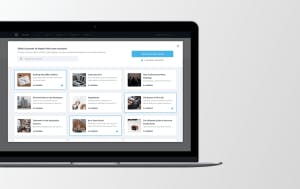Cross training your employees

In the gym, cross trainers (aka elliptical machines) give the body an overall workout, rather than just concentrating on one specific training target. Cross training employees can be thought of in a similar way. Instead of targeting only the knowledge and skills needed by employees for their current roles, cross training in the workplace broadens what they know and what they can do.
What is cross training?
Cross training definition is the method of training employees on roles and responsibilities that are outside the scope of their core work. It helps them expand their knowledge and skills that allow them to have a deeper understanding of the business. Awareness of the different specializations within the organization allows employees to realize their impact and contribution to the company’s goals. By developing flexibility among employees, you can ensure a seamless workflow when an employee takes a vacation or leaves the company. Similarly, it prepares employees in moving up to higher positions.
Cross training employees examples
Retail: If you teach your stock clerks to also operate the cash register, then a cashier out sick is not going to throw your staffing into an uproar.

Management: Companies with ageing management often have to hire replacements from outside. Yet, managers that have “grown with the organization” often have better insights about how to get things done effectively. See anyone with management potential? Have them start training now for the future.
Healthcare: The evolving role of nurses is a natural case study. Historically, nurses did a lot of low-level, “cleanup” tasks. Over time, their potential as partners to doctors was recognized. In many practices, nurses are trained to perform high level tasks, including a variety of complex procedures and even initial diagnostic assessments.
Benefits of cross training employees
As we can see from the cross training plan examples above, both employees and employers benefit. Let’s take a look at a few reasons why cross training is important in the workplace.
Learning new skills keeps engaged employees at the workplace. As a result, employers gain reduced staff absenteeism and a lower employee turnover rate. It promotes employee retention
Promotions from within offer employees a chance to see a long-term future with the same organization for a feeling of greater job security. Employers get people who perform better at a lower cost (the finding and training of outside hires is quite costly to organizations).
Knowing about the requirements and pressures of other jobs within the company enables employees to see the bigger picture. Employees have a better understanding of why things are the way they are and how they could be changed. Knowing about others at work tends to unify the staff. So, employers enjoy less negative, inter-departmental competitiveness and an atmosphere of more collaboration.
Another important benefit is organizational agility. With every day that passes, the future seems to be increasingly unpredictable. Organizations need to be able to “roll with the punches”, adapting themselves overnight to new marketplace needs and demands. Cross trained employees are more able to switch roles quickly, so companies can add staff in departments that suddenly need more workforce, trimming departments that no longer require so many workers.
Why is cross training employees important?
Perhaps the greatest win-win is that employees feel more satisfied at work. They feel the cross training shows that their employer believes in them and wants to invest in their future. As we all know, satisfied employees are more productive and creative in the workplace. They put in that little extra above and beyond so employee satisfaction is important.

How to cross train employees
1. Your cross training program should be part of your company culture, not an overnight start up during a crisis.
For many employees who are not familiar with it, cross training = layoffs. They figure that the organization’s needs have changed and that those who can’t learn the new ways of the working environment are going to be out. While this could be the case, it usually isn’t, so employees need to be reassured by human-resources and supervisors that their jobs are secure.
Other employees see a cross training job as a distraction from their “real work.” This is especially true of managers. Cross training is hours which take them away from what they are paid to be doing. All staff members need to understand that cross training is part of what they are paid to do, that it is part of their job description so to speak.
2. Respect should be paid to your employee’s existing workload.
When are your workers supposed to be doing the employee cross training plans? Do they need to find the time after their normal workday, so that the cross training cuts into their down time and family time?
The bulk of the cross training should be done during the workday. In other words, it needs to be scheduled just like other duties. One scheduling option is bit by bit each week. Another is several days of intensive training for the whole team or department while others pick up the slack. Find the solution that suits your workplace and honor it.
3. Who decides on the cross training topics?
On the one hand, it would be fine for the organization to choose cross training which benefits their overall goals. On the other, employees should have some say in what they learn. Being able to choose will increase the motivation and dedication of your employee learners.
Depending on how you set up your employee cross training, build in both company-selected modules as well as “your choice” opportunities.

4. Perks for learning are recommended.
Does it seem a given that all employees should cross train? It isn’t to most of them.
Even if you are giving them cross training hours during their normal workday, you are still asking them to put in a lot of effort. Keep in mind that quite a few people don’t like to study. Since they have a job already, they consider their studying days behind them.
Rewards for studying help a lot. Yet, we have to be careful. There is evidence for and against using an employee reward system to motivate learning. What does appear to work overall, though, are career-connected perks. For example: a course certificate or credentials that other organizations would recognize as valid; public employee recognition among peers; and, of course, career advancement.

5. Make sure that EVERYONE is involved.
When all the workforce is involved, from the top tier down to the lowest level, your chances of success are exponentially increased. In this case, companies’ training and development program of cross training employees is not seen as a punishment dreamt up by the big bosses. They are doing it, too. The CEO doesn’t waste an hour of your time telling you why cross training is important in the workplace and then disappears into his or her top floor office. He or she is seen in workshops, online courses, lectures, etc. just like other employees.
BONUS TIP
In today’s learning culture, a large part (perhaps even the majority) of your cross training will be online microlearning. This is due to the numerous benefits. Since you are investing resources in this learning system, you want it to be reliable, easy to set up and use, and professional-looking at the very least. Check out these further “must haves”.
If you are ready to offer your employees a “total workout” via cross training, click here.
You might be interested in EdApp’s Handling Objections with Emotional Intelligence course from the EdApp free content library!.


Author
